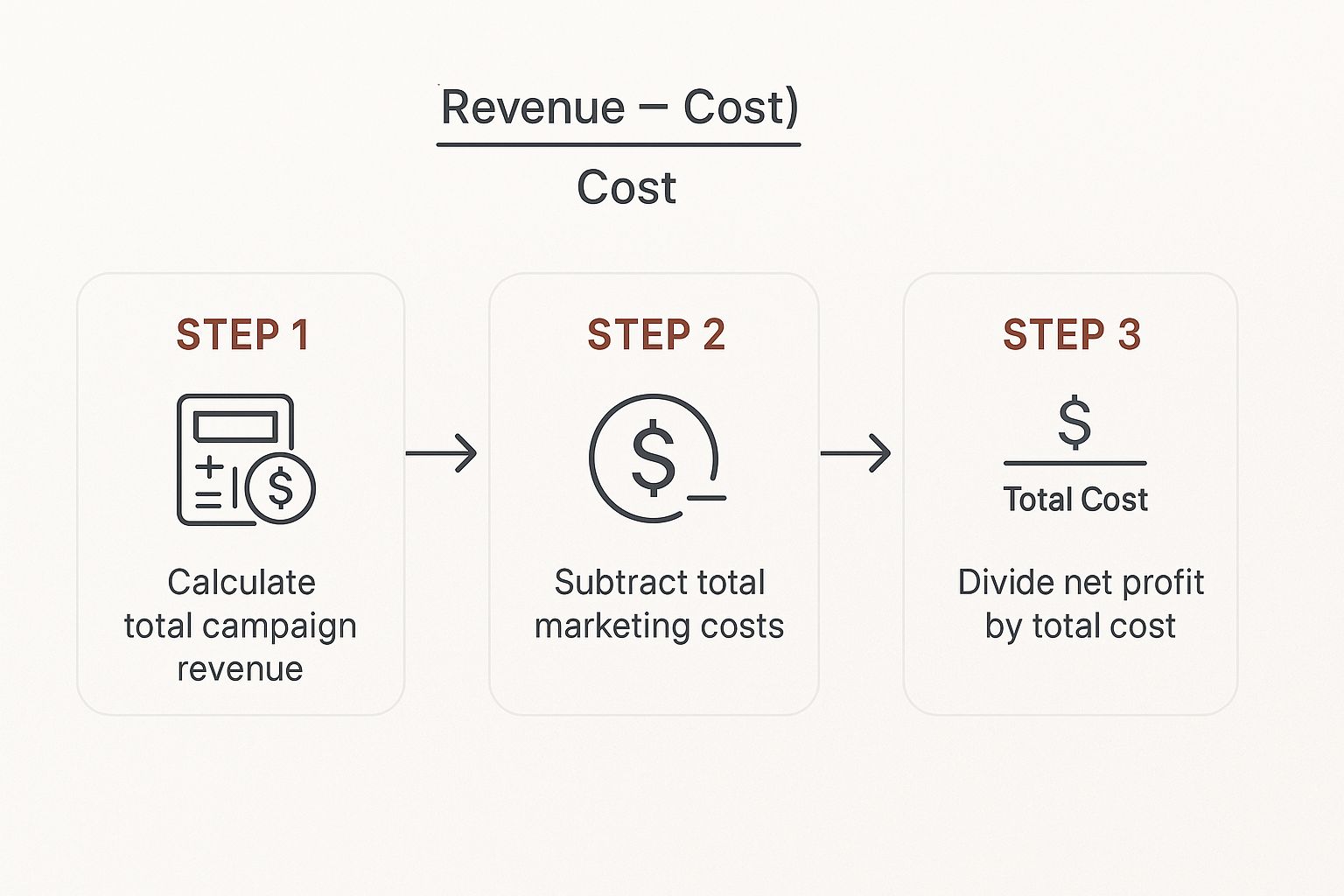At its core, measuring your marketing ROI is simply about proving your efforts bring in more money than they cost. It all boils down to tracking the right metrics, connecting sales back to specific campaigns, and plugging those numbers into a straightforward formula: (Sales Growth – Marketing Investment) / Marketing Investment. The result gives you a clear ratio or percentage that shows exactly what you’re getting back.
Why You Absolutely Must Measure Your Marketing ROI
Let's be honest: proving marketing's worth can feel like a constant uphill battle. You're pouring everything into launching campaigns, creating content, and running ads. But when leadership inevitably asks, "What did we get for that money?" a fuzzy answer about "brand awareness" just isn't going to fly. This is where knowing how to measure marketing ROI becomes your secret weapon.
It’s about changing the entire conversation. When you can consistently show a return on investment, marketing is no longer seen as just a "cost center." It becomes a predictable engine for revenue. Hard data has a way of silencing opinions and replacing guesswork with undeniable proof.
From Justifying Budgets to Driving Strategy
Having solid ROI numbers in your back pocket gives you the power to not only defend your current budget but to confidently ask for more. Imagine the difference between saying, "We need more money for ads," versus, "Every dollar we put into this campaign generates five dollars back. If we increase the budget by 20%, we can project an additional $X in revenue."
By consistently demonstrating a positive return, you build trust with leadership and earn a seat at the strategic table. Your insights become critical to business planning, not just a footnote in the expense column.
This data-driven approach empowers you to make smarter decisions, the kind that actually move the needle. You'll know with certainty which channels to double down on and which ones are just money pits.
The Real Cost of Flying Blind
Ignoring ROI is like driving with your eyes closed. Sure, you're moving, but you have no clue if you're headed for a cliff. The consequences aren't just theoretical; they can genuinely damage your business's bottom line.
Without clear performance data, you're practically guaranteed to experience:
- Wasted Ad Spend: You’ll keep pouring money into campaigns that look busy but deliver zero profitable customers. A high click-through rate means nothing if those clicks never turn into sales.
- Missed Growth Opportunities: It's easy to overlook a high-performing but low-volume channel that, with a little more investment, could become a massive source of growth.
- Inaccurate Forecasting: You'll be making business projections based on hope instead of historical performance, which almost always leads to missed targets and frustrated stakeholders.
Ultimately, making ROI measurement a core part of your workflow isn’t just about creating another report. It’s about building a culture of accountability and continuous improvement. That's what separates the marketing teams that make a real impact from the ones that just make noise.
Before you even think about calculating ROI, you have to get your tracking in order. It’s a classic case of "garbage in, garbage out." If your data is messy or incomplete, any ROI calculation you run will be built on a house of cards. You’ll just be guessing, and guessing is how budgets get wasted.
The real goal here is to draw a straight line from your marketing efforts to actual business results. We need to look past vanity metrics like clicks and impressions and zero in on what moves the needle: conversions, qualified leads, and cold, hard sales. This isn't just about plugging in some code; it’s a fundamental strategic shift.
And it’s more important than ever. By 2025, a staggering 83% of marketing leaders said that proving ROI was their number one job. Think about that: nearly five out of six executives are demanding to see the value behind every marketing dollar. It's no surprise that 64% of companies now decide future marketing budgets based on past ROI. Your ability to track accurately literally determines your future funding.
Getting Your Essential Tracking Tools Dialed In
First things first, let's talk about the bedrock of your measurement system: your analytics and CRM platforms. Getting these set up right is non-negotiable.
- Google Analytics (GA4): Don't just slap the tracking code on your site and call it a day. You need to define what a "win" looks like for your business by setting up specific conversion goals. Is it a user landing on a "thank you" page after filling out a form? Is it a click on the "Request a Demo" button? For an e-commerce site, it's obviously a completed purchase. You have to tell GA4 what to watch for.
- Customer Relationship Management (CRM): This is where you close the loop. Tools like HubSpot or Salesforce are mission-critical for connecting marketing activity to sales outcomes. When your CRM is properly integrated with your website, you can finally see that a specific blog post or a Google ad didn't just generate a lead—it generated a customer. That connection is the key to proving marketing's direct contribution to the bottom line.
A well-configured Google Analytics dashboard, for instance, gives you a clear view of which user actions are hitting your targets.

This kind of visibility is what helps you fine-tune your website and campaigns. If you want to dive deeper into improving site performance, check out these conversion rate optimization tips.
Master UTM Parameters to Track Every Single Source
If you’re not using UTM parameters, you’re flying blind. These are simple bits of code you add to the end of a URL, but they tell your analytics platform exactly where your traffic came from. It's the difference between knowing a lead came from "social media" and knowing it came from the specific Facebook ad you launched for your summer campaign.
I like to think of UTMs as digital breadcrumbs. They let you trace a user's journey all the way from the ad, email, or social post they clicked, right through to a conversion on your site. This gives you undeniable, crystal-clear attribution.
A well-structured UTM link usually has a few key parts:
- utm_source: This identifies the platform, like
google,facebook, ornewsletter. - utm_medium: This tells you the channel, such as
cpc,social, oremail. - utm_campaign: This names your specific marketing effort, like
summer_sale_2024.
So, a link for a Facebook ad promoting your summer sale would look something like this: yourwebsite.com/?utm_source=facebook&utm_medium=cpc&utm_campaign=summer_sale_2024.
Making this a standard practice for every single link you share externally brings discipline to your tracking. You eliminate the guesswork, account for every dollar, and build a clean data ecosystem. That's the foundation you need to calculate marketing ROI with total confidence.
Calculating Your Marketing ROI Without the Headache

Alright, let's get down to the numbers. Don't worry, you don't need a math degree for this. Figuring out your marketing ROI really just comes down to one simple, powerful formula that cuts through the noise and tells you what's actually working.
You've probably seen the classic formula for marketing ROI before:
(Sales Growth - Marketing Investment) / Marketing Investment
The result is your return, usually shown as a percentage or a ratio. So, if you get an ROI of 400%, it means you generated $5 in revenue for every $1 you spent. A solid 5:1 ratio. This one number is your clearest indicator of performance.
Defining Your Terms: What Really Counts?
Before you start crunching numbers, you have to be crystal clear on what each part of that formula means for your specific business. This is the single biggest stumbling block I see marketers hit; get this wrong, and your final number is practically useless.
What is "Sales Growth"?
This isn't just about your top-line revenue. You need to decide which growth metric truly reflects the impact of your marketing.
- Gross Revenue: The total sales generated. It's an easy place to start, but it doesn't factor in the cost of what you sold.
- Gross Profit: This is a much sharper metric. It’s your revenue minus the cost of goods sold (COGS), giving you a real sense of the profit your marketing created.
- Customer Lifetime Value (CLV): For any business that relies on repeat customers, this is the gold standard. CLV looks at the total profit a customer will bring you over their entire relationship with your brand, not just the first sale.
What is "Marketing Investment"?
This needs to be an all-in figure. It’s way more than just your ad spend.
- Ad Spend: The obvious one. What you paid directly to platforms like Google, Facebook, or LinkedIn.
- Tools & Software: Don't forget the subscriptions for your marketing automation, analytics platforms, design software, etc.
- External Help: Any fees for agencies, consultants, or freelancers have to be included.
- Salaries: A portion of your marketing team’s salaries dedicated to the specific campaign or channel you're measuring.
Getting these definitions right is the difference between a vanity metric and a real business insight. A comprehensive "Marketing Investment" figure prevents you from overstating your ROI and gives you an honest look at your true profitability.
Bringing the Formula to Life with Real Examples
Theory is one thing, but let's see how this works in practice. Applying the formula to a few different business scenarios makes it much easier to grasp.
Example 1: The E-commerce Brand's Google Ads Campaign
An online store selling custom-printed t-shirts wants to check the ROI on its latest Google Shopping campaign.
- Sales Growth (Gross Profit): The campaign drove $25,000 in revenue. The cost of blank shirts and printing (COGS) was $10,000, leaving them with a gross profit of $15,000.
- Marketing Investment: They spent $3,000 on Google Ads and $500 on a landing page tool that month. Total investment: $3,500.
Plugging it in: ( $15,000 - $3,500 ) / $3,500 = 3.28
Multiply by 100 to get the percentage, and you get a 328% ROI. That's a 3.28:1 ratio. For every dollar they put in, they got $3.28 back in pure profit. Not bad at all.
Example 2: The B2B SaaS Company's Content Marketing
A software company is measuring its content marketing ROI over a full quarter. This kind of long-game strategy needs a wider lens.
- Sales Growth (CLV): Their blog and whitepapers directly led to 20 new customers. With an average customer lifetime value of $5,000, the total value generated is $100,000.
- Marketing Investment: They paid a freelance writer $6,000, spent $2,000 on promoting the content, and allocated $12,000 of their content manager's salary to the effort. Total investment: $20,000.
Let's do the math: ( $100,000 - $20,000 ) / $20,000 = 4
Their content marketing produced a 400% ROI, or a 4:1 ratio. This proves the long-term, high-value impact of their content strategy.
Example 3: The Local Restaurant's Facebook Ads
A local pizza place ran a Facebook ad campaign to promote a new lunch special. Their goal was immediate, direct sales.
- Sales Growth (Gross Revenue): They used a unique coupon code in the ads. 200 people came in and redeemed the $15 special, generating $3,000 in revenue.
- Marketing Investment: The Facebook ad campaign cost them $500 for the month.
Here's the quick calculation: ( $3,000 - $500 ) / $500 = 5
The restaurant saw a massive 500% ROI, or a 5:1 ratio. The campaign was a clear win for driving foot traffic and immediate sales.
To make things even easier, here's a quick-reference table with the key formulas you'll need.
Key Formulas for Measuring Marketing Performance
This table breaks down the essential formulas for calculating your marketing return on investment and other critical metrics.
| Metric | Formula | What It Tells You |
|---|---|---|
| Marketing ROI | (Sales Growth - Marketing Investment) / Marketing Investment |
The overall profitability of your marketing efforts. |
| Cost Per Lead (CPL) | Total Marketing Spend / Total New Leads |
How much it costs to acquire a single potential customer. |
| Cost Per Acquisition (CPA) | Total Marketing Spend / Total New Customers |
How much it costs to acquire a single paying customer. |
| Customer Lifetime Value (CLV) | (Average Sale Value x Avg. # of Transactions) x Retention Period |
The total profit you can expect from a customer over time. |
| Conversion Rate | (Total Conversions / Total Visitors) x 100 |
The percentage of people who take a desired action (e.g., buy, sign up). |
Keep these formulas handy. They are the foundation of a data-driven marketing strategy that focuses on real results, not just clicks and impressions.
Choosing the Right Attribution Model for Your Business
So you've got the basic ROI formula down. It’s easy to stop there and think you have the full picture, but that's a common pitfall. The real story lies in how you assign credit for a sale—your attribution model.
Get this wrong, and your ROI numbers can lead you down a completely misguided strategic path. It’s the difference between seeing a clear roadmap and looking at your strategy through a funhouse mirror.
Think of it like a soccer team. A simple model gives all the credit to the player who scored the goal. It completely ignores the midfielders who created the opportunity and the defenders who started the play deep in your own territory. A modern customer journey is no different; dozens of small interactions often lead to that final conversion.
The Limits of Simple Attribution
The most common and most misleading model is last-click attribution. It gives 100% of the credit for a sale to the final marketing touchpoint a customer engaged with before buying.
Sure, it's easy to track. But it's dangerously simplistic. It gives all the glory to channels that are good at closing, like branded search ads, while completely undervaluing the channels that build awareness and trust, like your blog content or social media presence.
Relying only on last-click is like only watering the flowers while ignoring the roots. You might see a temporary bloom, but the whole plant will eventually wither. It pushes you to pour money into bottom-of-the-funnel tactics while starving the very channels that fill that funnel in the first place.
Exploring More Insightful Multi-Touch Models
To get a more honest look at what’s really working, smart businesses are turning to multi-touch attribution models. These models distribute credit across various touchpoints, acknowledging that the path to purchase is a journey, not a single step.
Each model tells a slightly different story, so picking the right one depends on what you want to achieve.
Here are a few popular ones I've seen work well:
- Linear Model: This is the diplomat of attribution. It assigns equal credit to every single touchpoint. It’s a solid starting point if you want to simply acknowledge that every interaction had some value.
- Time Decay Model: This one gives more credit to the touchpoints that happened closer to the conversion. It’s particularly useful if you have a short sales cycle where the most recent interactions are likely the most influential.
- U-Shaped (Position-Based) Model: This model gives the most credit to the first touch (for sparking awareness) and the last touch (for closing the deal), typically 40% each. The remaining 20% is then spread across all the interactions in the middle.
Choosing a multi-touch model isn't just a technical choice; it's a strategic one. It forces you to accept that the customer journey isn't a straight line, which helps you invest more intelligently across your entire marketing mix.
Let's see how this plays out. Imagine a customer buys a $100 product after these four interactions: they see a Facebook ad, read a blog post, click an email link, and finally, make the purchase through a Google search ad. A last-click model would give Google Ads all $100 of the credit, while a U-shaped model would give $40 to Facebook and $40 to Google, splitting the last $20 between the blog and email. Big difference, right?
The infographic below breaks down the basic steps for calculating ROI, a process that becomes much sharper when you're using the right attribution model.

This visual shows the core calculation, but remember, that "Revenue" figure is completely shaped by which marketing touchpoints you decide to credit for the sale.
Advanced Methods for True Causal Impact
Going beyond standard attribution, there are more advanced methods that help you understand true cause-and-effect. For instance, Marketing Mix Modeling (MMM) uses high-level statistical analysis to see how different marketing inputs impact sales over time. In fact, 49% of marketers were using MMM in 2023, with almost half of them planning to invest more.
But you don't need a massive budget for that. For many businesses, incrementality testing is a more accessible way to measure causation. This involves running controlled experiments, like holding back ads from a control group, to see the genuine "lift" a specific campaign actually provides. You can discover more insights about data-driven marketing and how it shapes ROI.
Ultimately, knowing how to measure marketing ROI isn't just about a formula. It’s about context. The attribution model you choose provides that context, helping you make smarter, more profitable decisions for your business.
Measuring ROI for Different Marketing Channels

Let's be clear: there's no magic formula for marketing ROI. Every channel in your mix is its own beast, with unique behaviors and contributions to your bottom line. Applying a one-size-fits-all approach is the fastest way to misread your data and, frankly, waste your budget.
The real key is tailoring your measurement strategy to the channel itself. What works for the instant gratification of paid search will tell you next to nothing about the long-term brand equity you're building with SEO.
Let’s dig into how you can get an accurate ROI reading from the channels that matter most.
Taming SEO ROI Beyond Traffic Metrics
SEO is the definition of a long game. Its value builds up over months, not days, so looking for a quick return is a recipe for frustration. The biggest mistake I see people make is obsessing over traffic and rankings. Sure, they’re important, but they don't pay the bills.
To get a real sense of your SEO return, you have to connect that organic growth directly to your business goals.
- Put a Price on Conversions: First things first, figure out what a conversion from organic search is actually worth. For an e-commerce site, this is easy, it’s the average order value. If you're B2B, it might be the projected value of a qualified lead from your demo request form.
- Isolate Organic-Driven Revenue: Dive into your analytics. You need to isolate the revenue generated specifically from organic search traffic. How many of those valuable conversions came from people who found you on Google?
- Play the Long Game: Compare the total revenue from organic over a six or twelve-month window against what you’ve invested in content, technical fixes, and your team. SEO is an asset that appreciates over time. If you need a refresher on the basics, you can learn more about what search engine optimization is and how it works.
My Pro Tip: Don't forget to track the lifetime value (LTV) of customers you win through SEO. In my experience, they often show higher loyalty and stick around longer, which dramatically boosts their long-term ROI compared to other channels.
Paid Search: The Direct Line to ROAS
Paid search, especially on platforms like Google Ads, gives you one of the clearest and most immediate views of ROI. The data flows in real-time, making the connection between your ad spend and revenue crystal clear. The two metrics that matter more than any others are Return on Ad Spend (ROAS) and Customer Acquisition Cost (CAC).
ROAS is your guiding light. It tells you exactly how much money you’re making for every dollar you put in. A 4:1 ROAS means for every $1 you spend, you’re bringing in $4 in revenue. Simple as that.
CAC, on the other hand, tells you how much it costs to bring a new customer through the door. This is where you get a much deeper understanding of your profitability. When you’re fine-tuning your campaigns, knowing how different tactics work is crucial. For instance, many advertisers achieve significant ROI with retargeting because it helps lower CAC by focusing on an already-warm audience.
The Social Media ROI Puzzle
Figuring out the ROI from social media can feel like you're trying to solve a puzzle. It’s a mix of direct sales and all the fuzzy stuff, like brand awareness and community building. This dual role is where most marketers get tripped up.
A recent global survey really nailed this issue. It found that while 97% of marketing leaders think they can explain social media's value, a mere 30% of marketers actually feel confident measuring its ROI. That's a huge gap, especially since 65% of leadership now wants to see a clear connection between social campaigns and business goals.
Here's how I break it down for a more practical approach:
- Track Direct ROI: This is the straightforward part. Use platform-specific tracking pixels and UTM-tagged links to trace sales that come directly from your social posts and ads.
- Value Indirect ROI: Assign a dollar value to actions that aren't sales, like newsletter sign-ups or e-book downloads from your social channels. Also, keep an eye on assisted conversions. This shows you how often social media played a role in a sale that eventually closed on another channel.
Email Marketing: The High-Return Powerhouse
Email marketing almost always delivers one of the highest ROIs out there. But that doesn't mean you can just set it and forget it. To measure its impact effectively, you have to look past simple open and click-through rates.
The metrics that truly matter for email ROI are Revenue Per Subscriber (RPS) and Campaign Revenue.
To find your RPS, just divide the total revenue generated from email by your total number of subscribers. This gives you a powerful benchmark for the health of your list and what each subscriber is worth to your business.
For specific campaigns, you need to track the revenue generated from every single email you send. By tagging your links and integrating your email platform with your CRM or e-commerce system, you can directly attribute sales to specific messages. This lets you see exactly which campaigns are hitting the mark and driving real financial results.
Answering Your Toughest Marketing ROI Questions
https://www.youtube.com/embed/MRkZJnirklE
Once you have the formulas and tracking in place, the real fun begins. You'll inevitably run into situations that don't fit neatly into a spreadsheet. That’s perfectly normal. Getting a handle on marketing ROI is a continuous learning process, not something you set up once and forget.
Let's dive into some of the most common questions I hear from marketers. These are the practical, real-world challenges that go beyond the textbook definitions, and I'll give you clear answers to help you navigate them.
What Is a Good Marketing ROI, Really?
This is the question on everyone's mind, and the most honest answer is: it depends. There's no universal magic number. A "good" ROI is completely tied to your industry, your specific profit margins, and what you're trying to achieve as a business.
As a general rule of thumb, a 5:1 ratio is a solid benchmark to aim for. This means you’re generating $5 in revenue for every $1 you spend on marketing. If you're hitting a 10:1 ratio, you're in an exceptional position.
But here’s the most critical part: profitability trumps everything. If your business runs on a 25% profit margin, you need at least a 4:1 ROI just to break even. On the flip side, a new startup gunning for aggressive growth might be perfectly happy with a 2:1 ratio for a while.
How Do I Measure ROI for Long-Term Plays Like SEO?
Trying to measure the return on long-game strategies like SEO or content marketing with a short-term lens is a recipe for frustration. You can't evaluate them like you would a PPC campaign that delivers results in days. The value here is cumulative—it builds on itself over time.
Instead of hunting for immediate spikes, you need to track the long-term value your efforts are generating. Here’s a practical way to do it:
- Put a price on conversions. First, figure out what an organic action is worth. What’s the dollar value of a demo request, a whitepaper download, or a newsletter signup to your business?
- Track growth over a longer timeline. Monitor how your organic traffic and those key conversions grow over a meaningful period, usually 6 to 12 months.
- Calculate the cumulative value. Add up the total value from all those organic conversions and stack it up against your total investment in content, technical SEO, and your team's time over that same period.
Think of SEO as an asset that appreciates. Your measurement approach has to reflect that reality.
How Often Should I Calculate and Report Marketing ROI?
The right reporting rhythm depends entirely on your sales cycle and the speed of your marketing channels. A one-size-fits-all schedule just doesn't work. You have to match your reporting frequency to the natural pace of your marketing.
For fast-moving channels like paid search, checking in on performance weekly makes sense. It lets you make quick, tactical adjustments to campaigns and ad spend before you burn through your budget.
For your overall marketing strategy, a monthly and quarterly cadence is the sweet spot.
- Monthly Reports: These are perfect for internal team check-ins. They help you make tactical pivots, see what's resonating, and keep the team aligned on short-term goals.
- Quarterly Reports: This is the ideal frequency for strategic reviews with leadership. It gives you a much bigger picture of performance and is crucial for making smart decisions about budget allocation and broader strategy.
Finally, an annual ROI analysis is non-negotiable for planning the upcoming year's budget and setting those high-level strategic priorities. The key is to find a consistent rhythm that gives your campaigns enough time to bear fruit while still allowing you to stay nimble.
Ready to stop guessing and start seeing real returns from your marketing? At Digital Lotus Marketing, we specialize in creating data-driven strategies that deliver measurable results. Let us help you build a marketing engine that not only looks good on paper but drives your bottom line. Learn more about our services.






